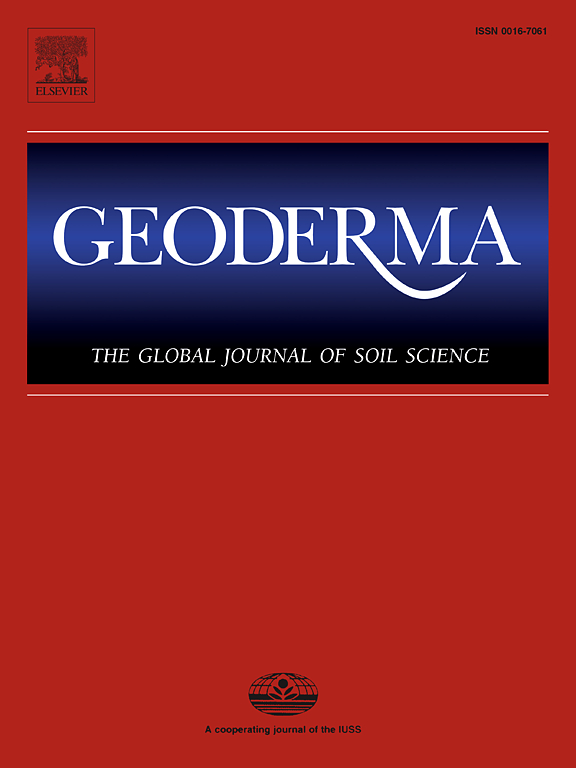温带森林生态系统中火山和非火山灰土壤底土二氧化碳排放的定量评价
IF 5.6
1区 农林科学
Q1 SOIL SCIENCE
引用次数: 0
摘要
底土(通常在30厘米以下)含有超过一半的全球土壤碳(C)作为土壤有机碳(SOC)。然而,地下土壤有机碳对全球碳循环的贡献程度及其控制因素尚不清楚,因为通过直接观测对地下土壤二氧化碳(CO2)排放的定量评估有限。本研究旨在量化土壤中CO2的排放,确定控制CO2排放的因素,重点研究土壤有机质(SOM)的分解性和土壤中矿物质- SOM的关联特征。因此,利用从日本四个森林遗址收集的两种不同土壤类型(火山灰和非火山灰土壤)的表层土壤(0-10 cm和10-25 cm深度)和底土(30-45 cm和45-60 cm深度)进行了实验室培养实验。来自地下土壤的二氧化碳排放量占所有站点上部60厘米矿物土壤总二氧化碳排放量的6% - 23%。从底土释放的CO2的放射性碳特征表明,几十年的SOM在底土中分解。两种土壤类型CO2排放速率与土壤因子的相关性表明,底土CO2排放主要受土壤微生物可利用的有机碳量和微生物生物量C的控制,而不受活性矿物的控制。考虑到地下土壤对陆地碳循环的潜在积极参与,目前大多数忽略地下土壤碳循环的土壤碳模型可能低估了土壤碳对未来气候变化的响应。对地下巨大碳库中碳循环的定量和机制理解,对于准确评价土壤碳在全球碳平衡中的作用至关重要。本文章由计算机程序翻译,如有差异,请以英文原文为准。
Quantitative evaluation of carbon dioxide emissions from the subsoils of volcanic and non-volcanic ash soils in temperate forest ecosystems
Subsoils (typically below a depth of 30 cm) contain more than half of global soil carbon (C) as soil organic C (SOC). However, the extent to which subsoil SOC contributes to the global C cycle and the factors that control it are unclear because quantitative evaluation of carbon dioxide (CO2) emission from subsoils through direct observations is limited. This study aimed to quantify CO2 emission from subsoils and determine factors that control CO2 emission, focusing on the decomposability of soil organic matter (SOM) and the characteristics of the mineral–SOM association in soils. Therefore, a laboratory incubation experiment was conducted using surface soils (0–10 cm and 10–25 cm depth) and subsoils (30–45 cm and 45–60 cm depth) collected from four Japanese forest sites with two different soil types (volcanic ash and non-volcanic ash soils). The CO2 emission from the subsoils was found to be responsible for 6 %–23 % of total CO2 emission from the upper 60-cm mineral soil across all sites. Radiocarbon signatures of CO2 released from the subsoils indicated the decomposition of decades-old SOM in the subsoils. The correlations between CO2 emission rate and soil factors across both soil types suggested that the CO2 emission from the subsoils is mainly controlled by the amounts of SOC easily available to soil microbes and microbial biomass C, not by the amounts of reactive minerals. Given the potential active participation of subsoils in terrestrial C cycling, most of the current soil C models that ignore subsoil C cycling are likely to underestimate the response of soil C to future climate change. The quantitative and mechanistic understanding of C cycling through a huge subsoil C pool is critical to accurately evaluating the role of soil C in the global C balance.
求助全文
通过发布文献求助,成功后即可免费获取论文全文。
去求助
来源期刊

Geoderma
农林科学-土壤科学
CiteScore
11.80
自引率
6.60%
发文量
597
审稿时长
58 days
期刊介绍:
Geoderma - the global journal of soil science - welcomes authors, readers and soil research from all parts of the world, encourages worldwide soil studies, and embraces all aspects of soil science and its associated pedagogy. The journal particularly welcomes interdisciplinary work focusing on dynamic soil processes and functions across space and time.
 求助内容:
求助内容: 应助结果提醒方式:
应助结果提醒方式:


